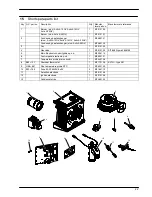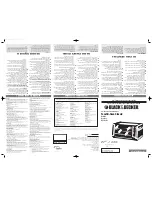
31
13
Flue temperature probe NTC and
Safety thermal fuse
13.1
Function
The Flue temperature probe NTC
A
in Fig. 13.1 and
Fig. 13.2 senses the temperature of the combustion
products that flow through the condensing heat ex-
changer.
A
Fig. 13.1
If the temperature of the combustion products circuit
reaches the limit temperature, the Flue temperature
probe NTC reduces the gas flow rate to the burner. The
temperature of the combustion products should de-
crease to a safe value temperature.
In the case that the temperature of the combustion
products reaches a potentially dangerous value, it
stops the boiler operation (lock---out).
This allows the use of plastic materials for the flue outlet
pipes and bends.
The use of kits different from the original isn’t however
allowed, since the flue pipes are integral parts of the
boiler.
A
B
Fig. 13.2
13.2
Removal
Warning: isolate the boiler from the mains
electricity supply before removing any
covering or component.
1
Remove all the case panels.
2
Disconnect the connector
B
from the Flue tem-
perature probe NTC by pressing the plastic hook
placed on the side of the connector.
3
Unscrew and remove the flue temperature probe
A (Fig. 13.2) from the condensing heat ex-
changer.
4
Assemble the Flue temperature probe NTC carry-
ing out the removal operations in reverse se-
quence.
13.3
Checks
n
Overheat temperature value
1
Run the boiler and set the temperature at maxi-
mum by pressing the appropriate key.
2
Allow the boiler to reach its maximum operating
temperature. The boiler should maintain a tem-
perature below that of the Flue temperature
probe NTC and no overheat intervention should
occur.
n
Temperature---resistance relationship
1
Remove the Flue temperature probe NTC (see
section 13.2).
2
Measure the Flue temperature probe NTC electri-
cal resistance at the ambient temperature and
check it according to the graph in Fig. 13.3
500
1000
1500
2000
2500
3000
3500
4000
4500
5000
5500
6000
6500
7000
7500
8000
8500
9000
9500
10000
10500
11000
11500
12000
12500
20 25 30 35 40 45 50 55 60 65 70 75 80 85 90 95 100
Ω
˚
C
Fig. 13.3




































